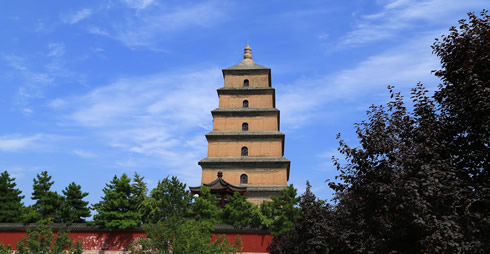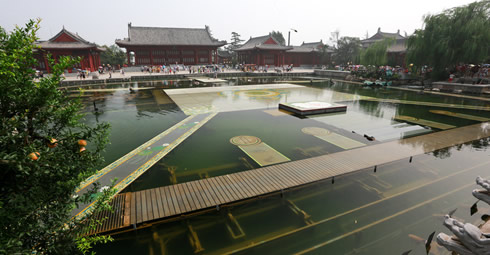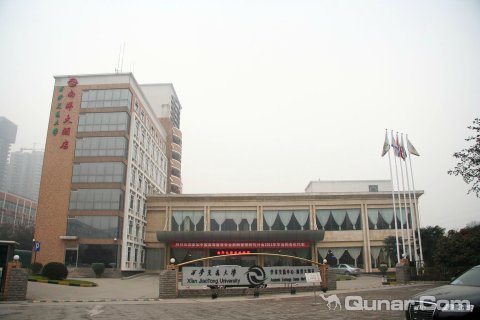Hotel
Xi'an Jiaoda Nan Yang Hotel is located in the south of Xi'an Jiaotong University, which occupies the area of about 20,000 m2. This international hotel enjoys favorable advantages by its unique position, convenient transportation and its garden-like design. It has a large parking lot holding 160 cars and it is surrounded by lawns, plants and fountains. All these make the hotel a quiet and peaceful garden inside the city, thus an ideal place for guests, tourists, business people and business activities.
西安简介(About Xi'an)
西安,古称“长安”。是举世闻名的世界四大古都之一,居中国古都之首,是中国历史上建都时间最久、建都朝代最多、影响力最大的都城,是中华民族的摇篮、中华文明的发祥地、中华文化的代表,有着“天然历史博物馆”的美誉。著名旅游景点秦始皇兵马俑、大雁塔、西安古城墙、华清池享誉中外。
Xi'an (西安), the capital of Shaanxi Province, located in the northwest of the People's Republic of China, in the center of the Guanzhong Plain. It is one of the oldest cities in China, the city was known as Chang'an before the Ming dynasty. Xi'an is the oldest of the Four Great Ancient Capitals of China, having held the position under several of the most important dynasties in Chinese history, including Zhou, Qin, Han, Sui, and Tang. Xi'an is the starting point of the Silk Road and home to the Terracotta Army of Emperor Qin Shi Huang. There are many tourist spots in Xi'an, such as the world-famous Terracotta Warriors (兵马俑), impressive Big Wild Goose Pagoda (大雁塔), grandiose Ancient City Wall (西安古城墙) and enchanting Huaqing Hot Spring (华清池).

Terracotta Warriors(兵马俑)
兵马俑,又称秦始皇陵兵马俑,坐落在距西安37千米的临潼县城东,南倚骊山,北临渭水,气势宏伟,是全国重点的文物保护单位。秦兵马俑坑位于秦始皇陵封土以东约1.5公里处,秦始皇兵马俑位于秦始皇陵的外围,有戍卫陵寝的含义。1975年7月10日,陕西省临潼县发现秦代兵马俑。1987年,秦始皇陵及兵马俑坑被联合国教科文组织批准列入《世界遗产名录》,并被誉为“世界第八大奇迹”。
The Terracotta Warriors, also referred as Terracotta Warriors and Horses, is located in east of Lintong District of Xian, China, lying Lishan Mountain in south and facing Weihe River in north. With its large scale and overwhelming momentum, the Terracotta Warriors is regarded as the Eighth World Wonder and was listed into 5A world cultural heritage in 1987. The Terracotta Warriors is a collection of terracotta figures showcasing the armies of Qin Shi Huang, the first Emperor of China. There are three main square-shaped pits hosting these warriors, chariots and horses.

Big Wild Goose Pagoda(大雁塔)
大雁塔位于和平门外4公里的慈恩寺内,相传唐代永徽三年,赴印度取经的玄奘法师奏请在寺内建塔,用于存放他自印度带回来的经籍。这座塔初名为经塔。后世人称它为大雁塔,此塔巍峨挺拔,引起世人的赞叹。大雁塔最初五层,后加盖至九层,再后层数和高度又有数次变更,最后固定为今天所看到的七层塔身,通高64.5米,被视为古都西安的象征。
Big Wild Goose Pagoda is a Buddhist pagoda located in southern Xi'an, which is an architectural marvel in China and regarded as the land mark of Xian, appealing numerous travelers home and abroad to pay a visit every year. Big Wild Goose Pagoda was started to build in 652 during the Tang Dynasty, rebuilt in in 704 during the reign of Empress Wu Zetian and renovated during the Ming Dynasty. The pagoda hosts sutras and figurines of the Buddha brought to China from India by Xuanzang, a prestigious Buddhist translator and traveler in Tang dynasty.

Ancient City Wall(西安古城墙)
Xian City Wall, square-shaped, is located in the downtown of Xian, 12 meters in width, 18 meters in the bottom-width and 15 meters in top-width. Xian city is enclosed by walls in four directions, which protects this ancient city solemnly. The east wall stretches 2590 meters long, west wall, 2631.2 meters, south wall, 3441.6 meters, and north wall, 3241 meters, with 13.7 kilometers in circumference. There are four gates equipped into the wall, namely Changle gate in east, Anding gate in west, Yongning gate in south and Anyuan gate in north.

Huaqing Hot Spring(华清池)
Huaqing Hot Spring, also referred as Huaqing Palace, is a complex of hot springs located at the northern foot of Lishan Mountain in Lintong District, Xian, lying Lishan Mountain in south and facing Weihe River in north. Huaqing Hot Spring is famous for its gurgling hot spring, breathtaking scenic views and mild weather, which makes itself the recreational palace of emperors of Zhou, Qin, Han, Sui and Tang dynasties. The site is perched 30 kilometers east of Xian city and neighbors the renowned Terracotta Warriors, the Eighth World Wonder. It was listed into 5A national tourist scenic area on May 8 in 2007.






